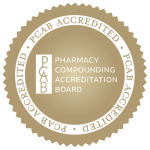Successful veterinary businesses use pharmaceutical compounding services to enhance their standard of care. Pharmaceutical compounding is the process utilized by compounding pharmacists to combine medicinal ingredients in precise strength and dosage amounts that allow veterinarians to prescribe custom medications to meet their patients’ unique needs.
Compounding is a centuries-old practice, but today’s compounding facilities are regulated by the State Boards of Pharmacy with superseding authority from FDA and use state-of-the-art technology and sophisticated equipment to provide creative solutions for practitioners and their patients. These modern methods require special training beyond that of traditional pharmacists, meaning that today’s compounding pharmacists are equipped to consult with practitioners and collaborate to provide safe, high-quality compounded formulations.
The Uses for Compounded Prescriptions
Prescription drugs on the current market that are both commercially available and FDA approved cannot meet the medication needs of all patients. In cases where those needs are not being met, pharmaceutical compounding may provide a useful solution to the patient. Here is a look at some of the many uses for compounded prescriptions.
- Avoiding Digestive Issues. If a patient cannot tolerate an oral medication because of digestive problems, a compounded formulation with a different route of administration, i.e. transdermal, rectal/vaginal, buccal, sublingual, or intravenous can be a better solution.
- Reducing Allergic Reactions. When a patient is allergic to one of the inactive ingredients in a prescribed commercial drug, a compounding pharmacist can prepare the same drug without that inactive ingredient.
- Lowering Barriers to Access. When a patient needs a drug that is hard to find has been removed from the market , a veterinary compounding pharmacy may be able to prepare that medication using an Active Pharmaceutical Ingredient (API) procured from an FDA approved and GMP regulated facility. Although it would be illegal for a compounding pharmacist to develop a drug solely as a cost-saving measure, it is often the case that an alternative compounded treatment using the same ingredients will be more affordable to the end user than the commercial option. A certificate of analysis verifies the drug’s potency and purity. Sought-after drugs may also be on back order. What is a patient to do – interrupt the treatment and wait until the drug is back in stock? A compounding pharmacy can prepare the medication, on an as-needed basis, for that patient.
- Proper Dosing. Aging animals or those with digestive sensitivities may benefit from compounding as a way of changing the delivery method of a drug. Where a dog or cat, for instance, resists a prescription in its pill form, perhaps they will respond differently to a liquid solution that could be injected orally. Or a therapeutic regimen involving several different drugs can be simplified into a customized formulation. By increasing the ease of delivery, A compounding pharmacist, in collaboration with a veterinary medical practitioner, may create a customized formulation that will allow the combination of the APIs in the drugs the patient is taking into a single preparation. This will increase the likelihood that they will be able to adhere to the treatment and ultimately improve their clinical outcome.
For all of the examples given above, there are countless other uses of compounding for veterinary patients. Additionally, the immense variety of therapeutic needs are ever-growing due to the increasing number of veterinary practice specialties.
Technical and Legal Considerations
It is important to mention, alongside our discussion of the myriad uses of compounded prescriptions, some of the technical and legal considerations influencing how these prescriptions are ultimately used.
As it is virtually impossible for commercial drug manufacturers to keep pace with market demand, it is important for veterinarians to be aware of the benefits of pharmaceutical compounding and its abilities to supplement commercial supply and help treat their patients. One of the key legal considerations that veterinary practices need to keep in mind, is the set of regulations enacted by the State Boards of Veterinary Medicine to encourage compliance with laws governing the use and distribution of compounded medications.
One of these regulations, for instance, determines that there must be an established Veterinary-Client-Patient Relationship (VCPR) when prescribing a (compounded) medication for a veterinary patient. A compounding pharmacist can only then process a prescription after verifying the validity of the prescription and the prescriber/veterinarian. Such regulations ensure that prescriptions fill a documented need.
Learn More About Compounding
HALDEY is a leader in veterinary compounding. Our cross-disciplinary team of MDs, PharmDs, and PhDs can customize a medication plan to fit your need. Contact one of our experts to learn more and find out what veterinary compounding can offer your practice and elevate your business.
Contact us to receive a free consultation.




